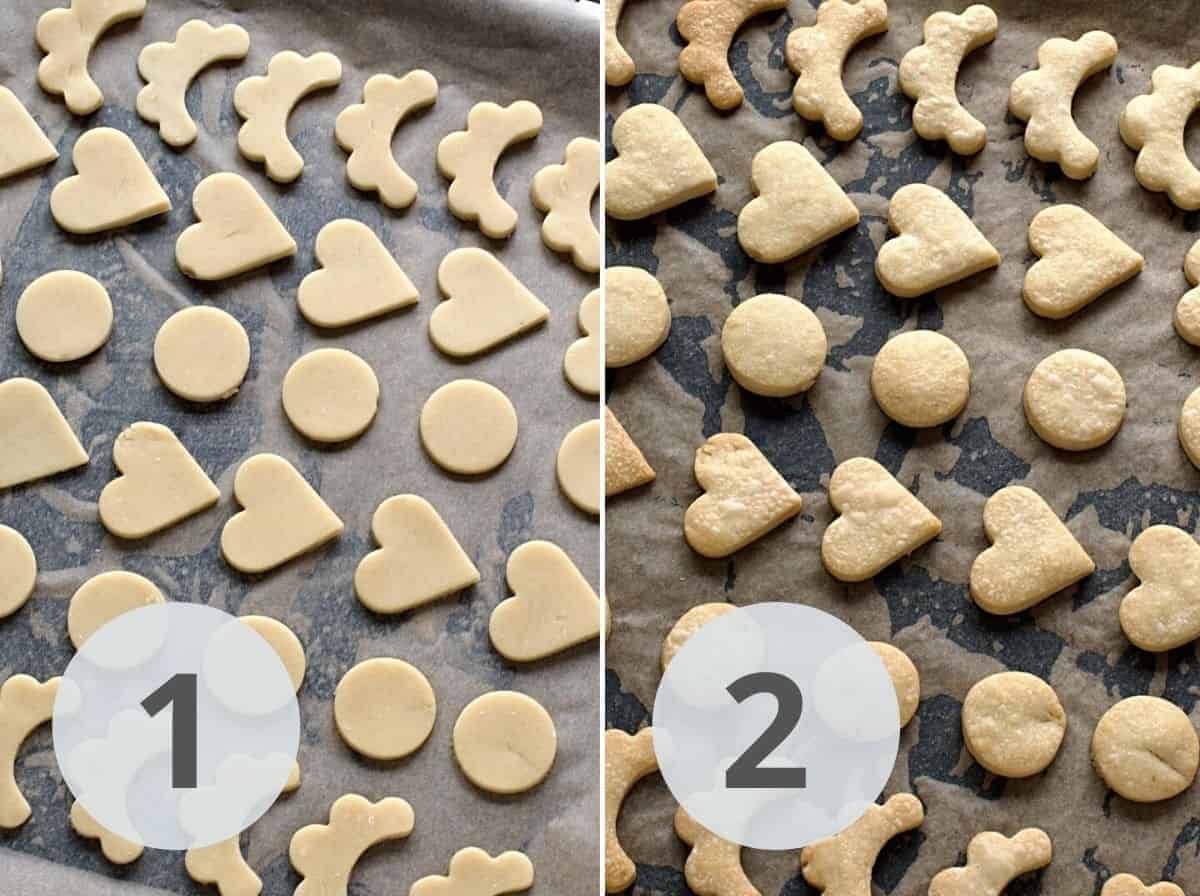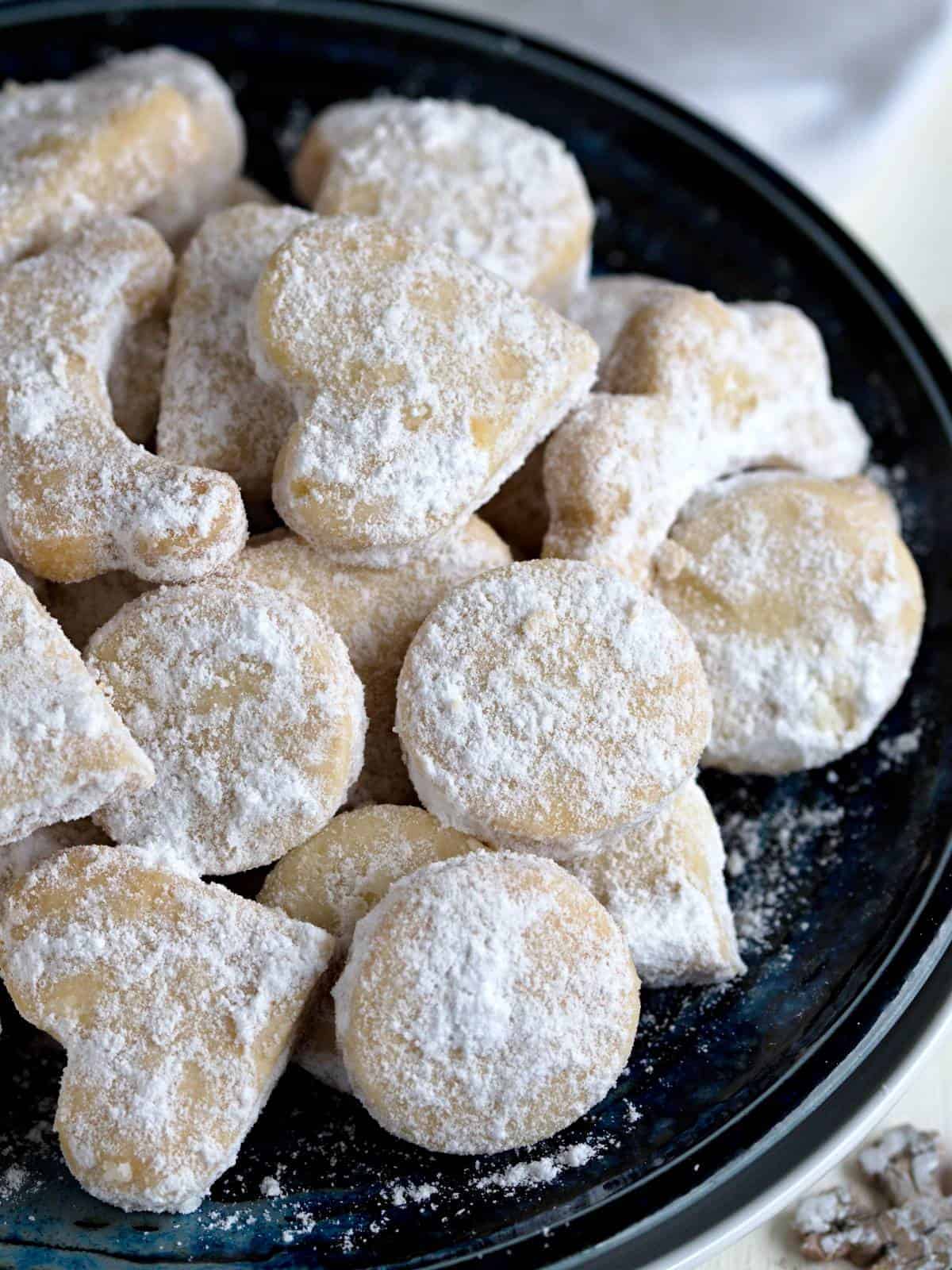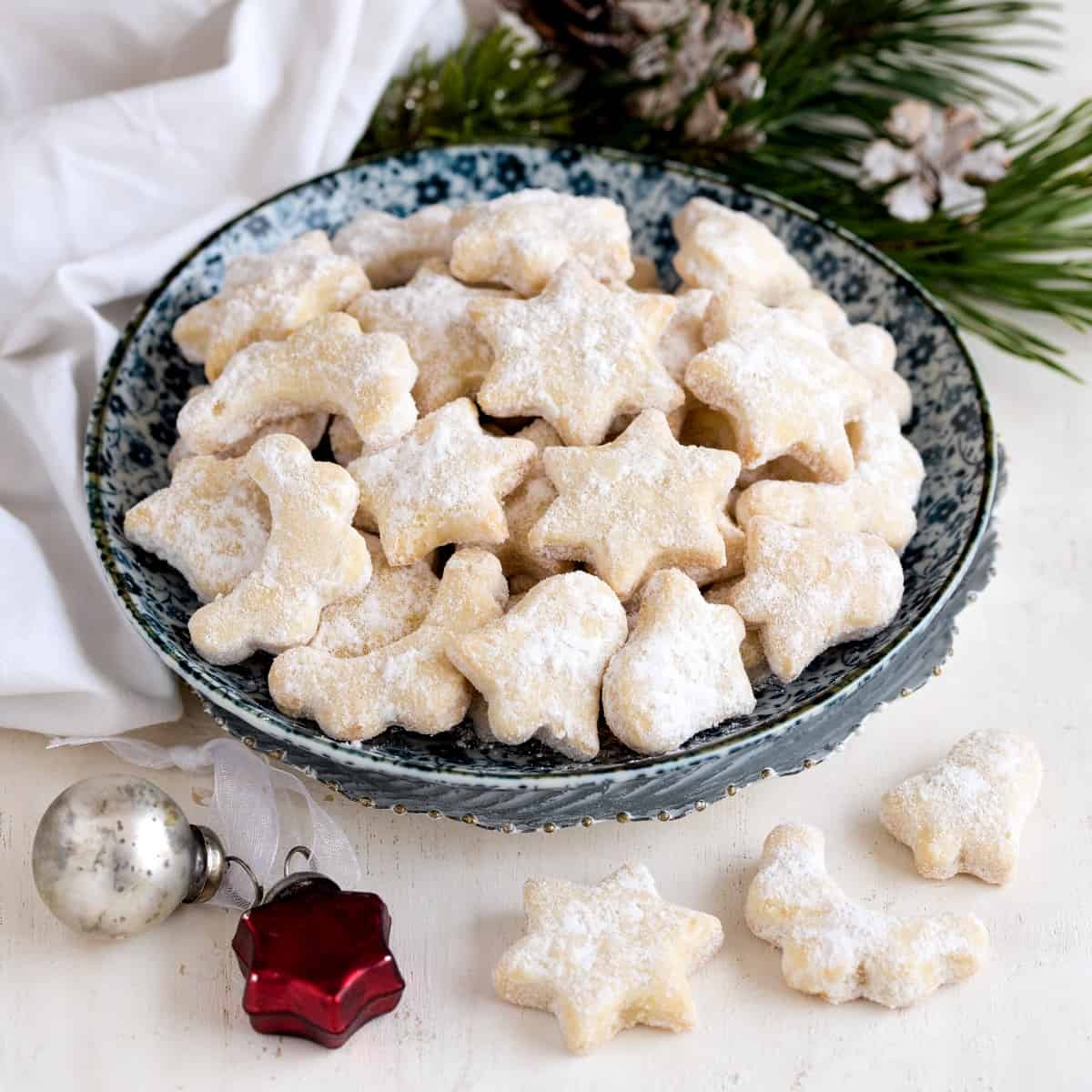Let's talk about podvodnice, an old Czech Christmas cookie that Bohemian grannies used to bake years ago. Many Czech families still bake it at Christmas; lots of modern homemakers have actually rediscovered podvodnice and added it to their favorite sweets list. I guarantee you will love them too!

➜ What Is Podvodnice?
Podvodnice is an old-fashioned Czech cookie baked at Christmas. The base consists of an easy 3-ingredient yeast dough, leavened under cold water! Various small shapes are cut off the dough, then baked and coated in powdered sugar as a final step.
Podvodnice cookies are perfectly tender and taste best when left to rest for several days after baking.
The other Czech names for this cookie are hastrmanci, vodnici, potapky.
The word podvodnice means "under water" and refers to the fact that the dough does not rise in the warmth of the air but is submerged in cold water.
MY TIP: Try out these Czech pracny cookies, they taste incredibly delicious!
➜ Ingredients

To make podvodnice, you'll need:
- All-purpose flour
- Unsalted butter; take it out of the refrigerator about half an hour to an hour in advance to soften
- Active dry yeast
- Coarse sugar; a little, to help activate the yeast
- Milk; lukewarm, to make a yeast starter
Next, get powdered sugar to coat the baked cookies. Mix with vanilla sugar if you have one for a better aroma.
✅ You’ll find the exact amount of ingredients below in the recipe card, which you can also print out.
➜ Instructions with Photos
STEP 1: Stir the sugar and dry yeast into the lukewarm milk. Mix with a spoon and leave in a warm place to rise for just 10-15 minutes. Once bubbles form on the surface, that’s a sign that the starter is ready to use.

STEP 2: Put the flour in a mixing bowl, add the softened butter pieces, and pour in the activated yeast. Work on the countertop into a smooth dough. Start with a fork, then use your hands.

STEP 3: Shape the dough into a ball. Put it in a bowl of cold water; the dough must be completely submerged. Place the bowl with the dough in a fridge and leave it to rise for two hours.

STEP 4: After two hours, take the dough out of the water and pat dry. Divide into two pieces and work each one with your hands until the dough softens a little. On a floured work surface, roll out the dough to a thickness of about 1/4 inch (0.6 cm) – not too thin!
STEP 5: Cut out small shapes from the rolled dough. Transfer them to a baking tray lined with baking paper.

STEP 6: Bake the cookies in a preheated oven at 360 °F / 180 °C (upper and lower heating) for 15 minutes. The dough will not get too golden on the surface but will puff up slightly and will be wonderfully tender after baking.

STEP 7: Roll the cookies in powdered sugar while still hot.

➜ Storage
Stack the podvodnice cookies in a clean paper box that you have lined with baking paper. Cover the top with a paper napkin and close the box with a lid. Store in a cool, dry place.
Freshly baked cookies are tender and will soften even more over time. They taste best a few days after baking. Prepare them about a week or two before Christmas if you intend to serve podvodnice cookies on the Christmas table.

➜ Useful Tips
- Cut the dough into smaller shapes; this way, the cookies will look the best.
- Work the dough quickly when rolling it out. The softer it is, the more flour you will need to dust it with, and the cookies become stiff.
More Christmas cookies:
- Walnut shaped cookies (orechy)
- Easy rum balls
- No-bake bee hives
- Heavy cream cookies (Czech slehackove cukrovi)
Tried this recipe?
Leave a review down in the comments! ⭐⭐⭐⭐⭐
Follow me on Facebook and Pinterest. Subscribe to my newsletter. Send me any question about Czech cuisine to my e-mail. I love hearing your feedback!

Podvodnice Czech Christmas Cookies
Ingredients
- 2 cups all-purpose flour (260 g)
- 1 and ½ stick unsalted butter (165 g) let it sit for 30 minutes at room temperature
- ¼ teaspoon granulated sugar
- 1 teaspoon active dry yeast
- 2 Tablespoons milk lukewarm
For coating:
- ½ cup powdered sugar
Instructions
- Stir the sugar and dry yeast into the lukewarm milk. Mix with a spoon and leave in a warm place to rise for just 10-15 minutes. Once bubbles form on the surface, that’s a sign that the starter is ready to use.
- Put the flour in a mixing bowl, add the softened butter pieces, and pour the activated yeast. Work on the countertop into a smooth dough. Start with a fork, then use your hands.
- Shape the dough into a ball. Put it in a bowl of cold water; the dough must be completely submerged. Place the bowl with the dough in a fridge and leave it to rise for two hours.
- After two hours, take the dough out of the water and pat dry. Divide into two pieces and work each one with your hands until the dough softens a little. On a floured work surface, roll out the dough to a thickness of about ¼ inch (0.6 cm) – not too thin!
- Cut out small shapes from the rolled dough. Transfer them to a baking tray lined with baking paper.
- Bake the cookies in a preheated oven at 360 °F / 180 °C (upper and lower heating) for 15 minutes. The dough will not get too golden on the surface but will puff up slightly and will be wonderfully tender after baking.
- Roll the cookies in powdered sugar while still hot.
Notes
- Makes about 70-80 smaller cookies.
- STORAGE: Stack the podvodnice cookies in a clean paper box that you have lined with baking paper. Cover the top with a paper napkin and close the box with a lid. Store in a cool, dry place.
- Freshly baked cookies are tender and will soften even more over time. They taste best a few days after baking. Prepare them about a week or two before Christmas if you intend to serve podvodnice cookies on the Christmas table.
- Work the dough quickly when rolling it out. The softer it is, the more flour you will need to dust it with, and the cookies will be stiff.
DISCLAIMER: Because I come from Central Europe, my recipes are based on metric units such as grams or milliliters. Check out how I convert metric units to the U.S. system:
Conversion chart





Julia
My grandma, who arrived in America from Bohemia in the 1930s always used to make these. The cookies may seem a little complicated, but they're very easy to make for more experienced cooks such as me. And they taste great!
Sam
Despite the person above who had to humble-brag about her cooking experience and her authentic Bohemian granny, I without any ties to the Old World or much self-proclaimed cooking experience was able to follow the recipe and make delicious cookies with a wonderful taste and texture. The cookies aren't complicated at all, just need an open mind and different technique than creaming butter with loads of sugar. And it helps immensely that the recipe is extremely well written with excellent pictures and measurements given by weight.
Petra Kupská
Yay, thank you for your nice comment and supportive words! 🙂 Christmas is sneaking up on us, and I love "podvodnice," so they'll appear on our Christmas cookie platter again this year!
Tori
I very much enjoyed my visit to Czech Republic and am excited to try this recipe. I'm curious about the scalloped crescent/ crown-shaped cookie shape in the pictures-- is it representing something special or just a random cookie cutter? Thanks and happiest holidays!
Petra Kupská
I'm so glad you enjoyed Prague! It is said to be one of the most beautiful cities in Europe. I can only agree. As for the cookie cutter, it's one of the random cutouts I have in my collection. Use whatever uncomplicated shapes you have available. I'll just point out that the cookie cutters should be about the same size. Otherwise, the Podvodnice cookies are a great choice. They are one of the less traditional but very tasty kinds of Czech Christmas cookies.
Jana
Thank you so much for this recipe-I had never heard of this cukroví, although I was born in Czechoslovakia, my mother had recipes for only four kinds…and we’d been making those foe more than 50 years…your posts have shown me several new ones that I have been trying.
I’m very grateful for you and your son who translated the recipes.
Anicka Cooklikeczechs.com
Hello Jana, thank you for your comment and kind words. I hope will enjoy the cookies!
Merry Christmas and greetings from the Czech Republic.